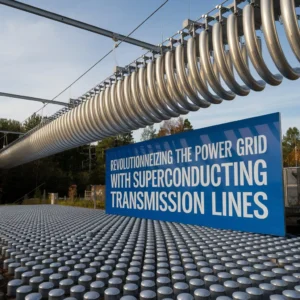The Potential of Superconducting Transmission Lines in Modern Energy Systems** – Envision a world in which energy loss during transmission is eliminated and electricity flows without resistance. Greetings from the exciting field of superconductivity, a phenomenon that still amazes physicists and has the potential to completely transform our energy systems. Superconducting transmission lines are looking like one of the most viable ways to create smarter, more efficient grids worldwide as we approach the next great energy revolution. We’ll go into great detail about these amazing materials’ functions, possible effects on the integration of renewable energy sources, and reasons why they might be essential in forming a sustainable future in this blog post. Fast-forward to an exciting new era as we examine how superconductivity will revolutionise power distribution and propel humanity forward!
Overview of Superconductivity and Energy Systems Applications
Envision a world in which energy is used as efficiently and as little as possible, with little loss. Superconductivity is an exciting field that is making this vision more and more real. Superconductors are substances that, when cooled below a specific temperature, have the ability to conduct electricity without any resistance. There is a great deal of potential for this amazing phenomenon to change our energy systems.
Creative solutions are essential as we deal with the problems posed by climate change and an increasing need for electricity. Let us introduce superconducting transmission lines, an innovative development that has the potential to completely transform the way we send power across long distances. These cutting-edge lines have special qualities that have the potential to revolutionise energy distribution and make it more ecologically and economically sustainable.
Are you wondering what is so unique about superconducting transmission lines? Let’s examine their benefits, present uses, upcoming difficulties, and potential future in contemporary energy systems.
Superconducting Transmission Lines
Superconducting transmission lines are novel, resistance-free electrical conductors. They are remarkably efficient at carrying power thanks to this special quality.
Certain materials become superconductive at very low temperatures. They can transfer a lot of current in this state with very little heat loss. There are important ramifications for energy systems.
The functionality and architecture of these lines are different from those of conventional power lines. Superconducting cables preserve the integrity of the electric flow across extended distances, whereas normal cables lose energy as a result of resistance.
The way we move power across large networks could be completely changed by this technology, opening the door for more intelligent grids and effective energy distribution plans. These cutting-edge solutions have the potential to change our perception of power connectivity in contemporary society as research continues.
Superconducting transmission lines
. Efficiency is one of its most notable advantages. Superconductors, in contrast to traditional systems, have the ability to carry electricity without resistance, resulting in very little energy loss during transmission.
These cutting-edge lines also offer a remarkable power capability. When compared to conventional cables, they are able to move more electricity in the same amount of physical space. This makes it possible to reduce the amount of right-of-way needed and streamline the infrastructure.
An important consideration in this comparison is the environmental impact. During operation, superconducting lines emit less emissions and require less land. These traits increase in value as cities grow and renewable energy sources multiply.
Superconductors can also function at temperatures higher than before. This adaptability creates opportunities for novel applications that have the potential to transform our energy environment and improve grid resilience and dependability against disruptions or variations in demand.
Better Performance and Reduced Energy Wastage
Transmission lines that are superconducting redefine energy efficiency. Superconductors enable lossless electricity flow in contrast to conventional wires, which include resistance. This indicates that almost all of the energy produced gets to where it’s going.
Imagine living in a future where energy transfer waste is negligible, resulting in cheaper electricity bills. This is made feasible by superconducting technology, which does away with the heat generation that comes with traditional wiring.
Smarter grids are made possible by the capacity to carry large amounts of electricity without experiencing any loss. Long-distance energy transmission is more efficient, allowing distant renewable energy sources to be connected to urban areas in need of clean energy.
Enhanced superconducting efficiency becomes crucial as we work towards resilience and sustainability in our energy systems. A greener future depends on ensuring that every electron counts, not only on saving money.
Greater Transmission Capacity of Power
Transmission lines that are superconducting have a much higher electrical carrying capacity than conventional copper or aluminium wires. This is because superconductors have special qualities that make it possible for them to carry electricity without resistance.
They can therefore withstand greater currents without overheating. Less transmission lines are required to supply the same amount of power thanks to this enhanced capacity.
Imagine densely populated urban environments. Superconducting cables have the potential to reduce traffic on current infrastructure and provide a steady supply of energy.
Furthermore, this capability creates new avenues for directly connecting distant renewable energy sources to cities. Densely inhabited areas can effectively receive sustainable energy from wind farms and solar systems.
The capacity to smoothly integrate huge volumes of power improves the stability and flexibility of the grid. Superconducting technology is a viable way to efficiently meet future energy needs as demand increases.
Diminished Effect on the Environment
When compared to conventional power systems, superconducting transmission lines offer a considerable reduction in environmental effect. These cutting-edge technologies contribute to a reduction in greenhouse gas emissions linked to the production of electricity by minimising energy loss during transmission.
Furthermore, superconductors don’t require a lot of additional infrastructure to handle high current loads. This implies that less land disturbance and fewer materials are needed for installation. A smaller ecological footprint overall and less habitat loss result from the smaller footprint.
Furthermore, ecological techniques are frequently incorporated into creative designs. For example, many projects try to employ as much recyclable or eco-friendly material as they can. This strategy supports international environmental objectives while also enhancing the installations’ longevity.
Adopting superconducting technology may be essential to creating healthier urban environments and promoting economic growth through effective energy solutions as cities expand and energy demands rise.
Applications and Advancements in Superconducting Transmission
Superconducting transmission lines are causing a stir in a number of industries. Cities such as Los Angeles have started pilot programs in urban settings with the goal of incorporating this technology into their current grid systems.
These lines guarantee reliable power distribution in addition to efficiency, which is important in heavily populated areas.The creation of a superconducting wire in South Korea is another noteworthy instance. Here, scientists are attempting to transmit energy across large distances while reducing losses and improving stability.
These advances are being keenly watched by energy corporations around the world, as they have the potential to transform the way we transmit electricity both now and in the future.
Limitations and Difficulties of Superconducting
Superconducting transmission line implementation comes with a number of considerations that must be carefully considered. The price and accessibility of the materials needed for their construction represent a significant obstacle. Although they seem promising, high-temperature superconductors can be costly and challenging to find.
Technical difficulties are also quite important. Sophisticated engineering solutions are needed to design these systems in a way that can efficiently handle cryogenic cooling. Installation procedures are intricate and call for certain knowledge.
Furthermore, there are logistical challenges in incorporating superconducting technology into the current infrastructure. Current power grid retrofitting can be expensive and time-consuming, potentially causing service interruptions while improvements are made.
The regulatory environment also contributes to the complexity. The process of navigating permissions and regulatory regulations can cause projects to lag considerably, which will postpone the benefits of this breakthrough technology in energy transmission from being realised.
Material Cost and Availability
Technical Difficulties in Installation and Design
Superconducting transmission line design presents a unique set of technological challenges. Sustaining the extremely low temperatures needed for superconductivity is a major difficulty. This frequently calls for sophisticated cooling systems, which can be expensive and complicated.
Engineers also have trouble choosing the right materials. Superconductors’ qualities must be carefully considered during design in order for them to endure high electrical currents without losing efficiency.
Another level of intricacy is introduced by installation. Because superconducting wires are sensitive, it is necessary to train workers with the necessary precision and experience.
More difficulties arise during integration with the current infrastructure. To integrate these cutting-edge technologies into conventional power systems, careful planning and creative engineering solutions are needed. It may be necessary to carefully manage each project’s particular challenges in order to successfully utilise this promising technology.
Case Studies: Superconducting Transmission Lines Successfully Implemented in Energy Systems
Superconducting transmission lines have shown to be beneficial in a number of ground-breaking projects. The Albany project in New York is one prominent instance. It has a superconducting wire with a 600-meter length and much lower energy loss.
In another example, the magnetic train system of Japan’s Chuo Shinkansen line is powered by superconductors. This creative strategy reduces environmental effect while increasing efficiency.
Nor is Europe falling behind. A one-kilometer superconducting cable used in the AmpaCity project in Essen, Germany, can transfer high voltage with little energy loss.
These case studies demonstrate how these cutting-edge systems can be incorporated into the current infrastructure, suggesting a radical change in the ways that energy is distributed throughout the world.

Prospects for the Future: Possible Effect on the Current Power System
Superconducting transmission lines have the potential to revolutionise the current electrical system. These cutting-edge technologies could greatly improve grid resilience, making it easier for it to tolerate variations and disruptions.
Superconducting technology can effectively carry more electricity over longer distances as energy demands rise. As metropolitan areas grow and renewable energy sources proliferate, this capability will become increasingly important.
Superconductors can also be integrated into the current infrastructure to create opportunities for a more varied energy portfolio. These lines could aid in stabilising output from sporadic sources by smoothly integrating solar and wind electricity.
They are positioned as leaders in sustainable development in the energy sector due to their little environmental impact. As new breakthroughs keep coming out, we might live in a day where clean energy easily travels across enormous networks, empowering local communities and lowering their need on fossil fuels.
Increased Sturdiness and Dependability
The resilience of contemporary power grids is expected to be significantly increased by superconducting transmission lines. These sophisticated lines, in contrast to traditional systems, can withstand large load fluctuations without overheating or experiencing losses. When demand is at its highest, traditional infrastructures may not be able to withstand the strain.
Superconductors are also less vulnerable to disturbances brought on by bad weather or external damage. Their intrinsic qualities produce a more constant energy flow, guaranteeing that users will consistently receive electricity even in unfavourable circumstances.
Grid reliability is further improved by the capacity to transmit power across long distances with negligible loss. Distant regions can maintain seamless connectivity, diminishing reliance on nearby resources and broadening the range of available supply choices.
With population growth and climate change causing energy needs to vary quickly, superconducting technology provides the flexibility we need to keep our infrastructure resilient.
Combining Renewable Energy
There is a great deal of promise in superconducting transmission lines to incorporate renewable energy sources into our power infrastructure. These cutting-edge lines have the potential to be extremely important in controlling the unpredictability of renewable energy sources like solar and wind power as the globe moves more and more towards greener energy options.
Superconducting lines facilitate effective connectivity between distant renewable energy facilities and urban areas by enabling long-distance electrical transmission without notable losses. This is especially crucial because an increasing number of wind farms are situated in remote or offshore locations, distant from the sources of supply.
Superconductors can also contribute to grid stabilisation by enabling quick response times during variations in energy output. They improve the power system’s overall reliability and enable more effective management of peak loads. By integrating these technologies with the current infrastructure, smarter grids that can easily handle a variety of energy sources may become a reality.
Superconducting transmission lines have the potential to significantly contribute to the resilience and sustainability of our energy systems as long as we continue to innovate in this area. As we take use of their potential to support renewable energy sources and lessen our need on fossil fuels, the future appears bright.

